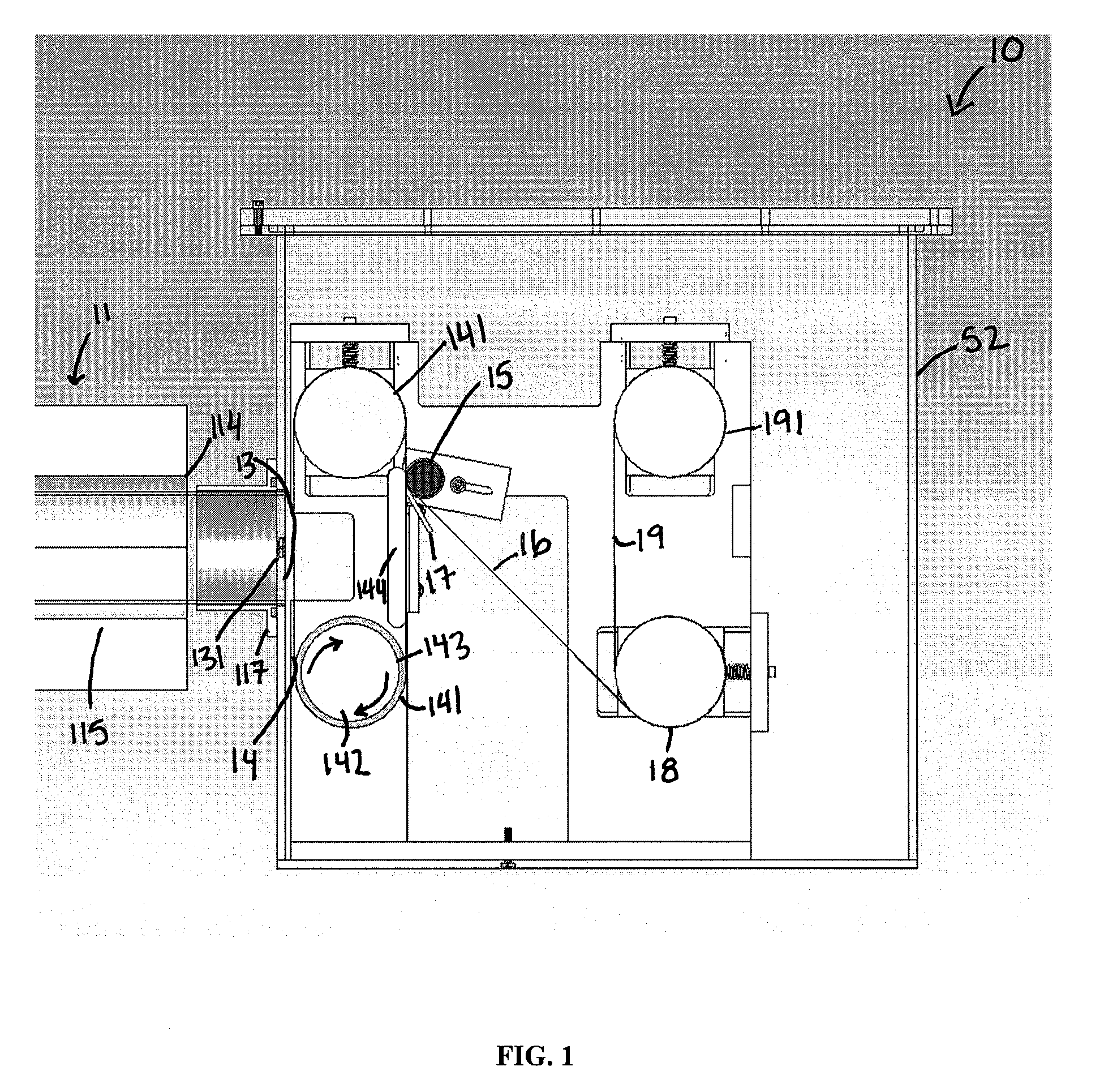Materials for Thermal Protection and Methods of Manufacturing Same
a technology of thermal protection and materials, applied in the field of flame-resistant materials, can solve the problems of affecting the overall reaction kinetics, affecting the electrical conductivity of nox®, and blocking the exiting of nanomaterials from the chamber,
- Summary
- Abstract
- Description
- Claims
- Application Information
AI Technical Summary
Benefits of technology
Problems solved by technology
Method used
Image
Examples
example i
[0047]Non-woven sheets of carbon nanotubes are created by a CVD process using system 10 shown in FIGS. 1, 2 and 2A. Nanotubes are created in the gas phase and deposited on a moving belt as noted above. A plurality of layers may be necessary to build the non-woven sheet to a density, in an embodiment, of about 1 mg / cm2. Density of the non woven sheet can be controlled within a wide range, for instance, from at least about 0.1 mg / cm2 to over 5 mg / cm2. An example of such a non-woven sheet is shown in FIG. 3 as item 30.
[0048]The bulk nanomaterials from which the non-woven sheet 30 is made can also provide sheet 30 with high strength. In an embodiment, the non-woven sheet 30, made from either single wall (SWNT) or multiwall (MWNT) carbon nanotubes, may be provided with a nominal strength ranging from about 10K to about 20K psi, so that it can be easily handled while being substantially flexible. In accordance with one embodiment, non-woven sheet 30 may have a tensile strength that can be...
example ii
[0053]In order to employ the non-woven sheet 30 in a thermal protection or management application, the non-woven sheet 30, in one embodiment, can be bonded to a substrate material. Examples of a substrate material includes Nomex® or any other type of textile or substrate for which thermal protection is desired, including metal, such as aluminum foil, structural aluminum components, stainless steel, Incontel, titanium, or the like.
[0054]With reference now to FIG. 4, in accordance with one embodiment, a non-woven sheet of the present invention may be bonded to a commercial grade Nomex® basket weave, 8.4 oz / yd, and thickness of 0.0152 inches to provide a thermal protection sheet 41. Bonding of the non-woven sheet to the substrate material can be accomplished through the use of an adhesive having a glassy carbon precursor material. In an embodiment, an adhesive that can form a char, rather than melts or destructively bums in the presence of relatively high heat may be used. Examples of ...
example iii
[0059]In another embodiment, the non-woven carbon nanotube sheet of the present invention, such as sheet 30, or the thermal protection sheet 41 can be coated with Polyureamethylvinylsilazane Ceraset™ (Kion Corporation, Huntingdon Valley, Pa.) (referred to hereinafter as “Ceraset”) to enhance the strength of the non-woven sheet or thermal protection sheet 41 and its oxidation resistance characteristics. Of course, the non-woven carbon nanotube sheet or the thermal protection sheet 41 may be used without a coating of this material.
[0060]To form the coating material, the Ceraset may be dissolved in acetone solutions in concentrations ranging from about 1% to about 20%, preferable around 5% by volume. Next, the solution may be coated onto the non-woven carbon nanotube sheet or the thermal protection sheet 41, and then allowed to air dry. Thereafter, the coated non-woven sheet or the coated thermal protection sheet 41 may be hot pressed at an elevated temperature ranging from about 50° C...
PUM
| Property | Measurement | Unit |
|---|---|---|
| Temperature | aaaaa | aaaaa |
| Temperature | aaaaa | aaaaa |
| Temperature | aaaaa | aaaaa |
Abstract
Description
Claims
Application Information
 Login to View More
Login to View More - Generate Ideas
- Intellectual Property
- Life Sciences
- Materials
- Tech Scout
- Unparalleled Data Quality
- Higher Quality Content
- 60% Fewer Hallucinations
Browse by: Latest US Patents, China's latest patents, Technical Efficacy Thesaurus, Application Domain, Technology Topic, Popular Technical Reports.
© 2025 PatSnap. All rights reserved.Legal|Privacy policy|Modern Slavery Act Transparency Statement|Sitemap|About US| Contact US: help@patsnap.com



